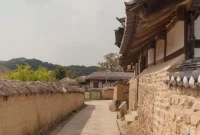Korean Hanbok Fashion: Modern Trends and Traditions
The Evolution of Hanbok Fashion
Hanbok, the traditional Korean attire, has a rich history that spans centuries. In recent years, the fashion industry has witnessed the evolution of Hanbok, as it merges with modern trends while preserving its cultural traditions.
One notable trend in Hanbok fashion is the incorporation of contemporary elements. Designers are adding unique touches such as vibrant colors, modern patterns, and unconventional silhouettes to make Hanbok more appealing to younger generations.
Additionally, there has been a rise in Hanbok-inspired street style. Fashion enthusiasts and K-pop idols are often seen blending traditional Hanbok pieces with Western garments, creating a fusion of cultures that is both stylish and captivating.
Despite the modern influences, Hanbok’s traditional essence remains intact. Classic Hanbok designs, characterized by flowing lines, graceful curves, and intricate embroideries, continue to be cherished and worn during special occasions such as weddings, celebrations, and traditional ceremonies.
The popularity of Hanbok has also extended beyond Korea’s borders. Internationally renowned designers have showcased Hanbok-inspired collections on prestigious runways, further promoting its significance and allure worldwide.
As Hanbok fashion continues to evolve, it serves as a testament to the adaptability and timelessness of Korean culture. The combination of tradition and innovation in Hanbok design represents the ongoing dialogue between the old and the new, creating a harmonious blend that captivates fashion enthusiasts worldwide.
The Influence of K-pop on Hanbok Trends
As an integral part of South Korean culture, the traditional Hanbok has evolved over time to incorporate modern elements thanks to the influence of K-pop. With the rise of popular K-pop groups, such as BTS, BLACKPINK, and EXO, Hanbok fashion has gained international attention and undergone various transformations.
One noticeable influence of K-pop on Hanbok trends is the incorporation of vibrant colors and bold patterns. K-pop idols often showcase Hanboks in their music videos and performances, featuring eye-catching designs that appeal to a younger audience. This has led to a resurgence of interest in Hanbok fashion, not only in traditional Korean settings but also in modern contexts.
Another aspect influenced by K-pop is the fusion of Hanbok with contemporary fashion. Many designers have modernized the Hanbok silhouettes by combining them with Western-style clothing, creating a unique blend of traditional and modern elements. This fusion has made Hanbok more accessible and appealing to a broader range of people, both within and outside of Korea.
K-pop’s impact on Hanbok extends beyond fashion. The music industry has also played a significant role in promoting Hanbok as a symbol of Korean identity and pride. Many K-pop artists deliberately incorporate Hanbok in their concept photos, album covers, and stage performances, reinforcing the connection between traditional culture and modern entertainment.
In conclusion, K-pop’s influence on Hanbok trends is undeniable. Through vibrant colors, fusion with contemporary fashion, and promoting it as a symbol of Korean identity, K-pop has contributed to the modernization and increased global interest in Hanbok fashion.
Preserving Hanbok: Traditions and Cultural Significance
In the world of Korean fashion, Hanbok holds a unique position as a symbol of tradition and cultural significance. This traditional attire, characterized by its vibrant colors and elegant designs, is not only a fashion statement but also a testament to the rich history and customs of Korea.
While modern fashion trends have inevitably influenced the way people dress, efforts are being made to preserve the essence of Hanbok. Various organizations and individuals have taken up the task of promoting and reviving Hanbok, ensuring that this cherished cultural heritage continues to thrive.
One key aspect in preserving Hanbok is its integration into contemporary fashion. Designers today are incorporating Hanbok elements into their modern designs, creating a fusion of traditional and modern styles. This has sparked a renewed interest in Hanbok among the younger generation, helping to keep the tradition alive.
Another important preservation measure is education. Schools and cultural institutions offer courses and workshops on Hanbok making and wearing, allowing people to learn about the craftsmanship and etiquette associated with this attire. By passing down these skills and knowledge, the tradition of Hanbok can be carried forward to future generations.
The significance of Hanbok extends beyond its aesthetic appeal. It serves as a visual representation of Korean identity and heritage, reflecting the values and social structure of the past. Preserving Hanbok is a way of honoring the ancestors and maintaining a connection to the roots of Korean culture.
As we navigate the ever-changing landscape of fashion, it is crucial to recognize and celebrate the cultural significance of traditional attire like Hanbok. By preserving this cherished tradition, we can ensure that the beauty and legacy of Hanbok continue to be appreciated for years to come.
Conclusion
In conclusion, Korean Hanbok fashion combines modern trends with traditional elements, resulting in a unique and captivating style. With its vibrant colors, exquisite craftsmanship, and attention to detail, the Hanbok continues to be cherished as a symbol of Korean heritage and national identity. The fashion industry’s increasing recognition and appreciation of the Hanbok has led to its integration into contemporary designs worldwide.




